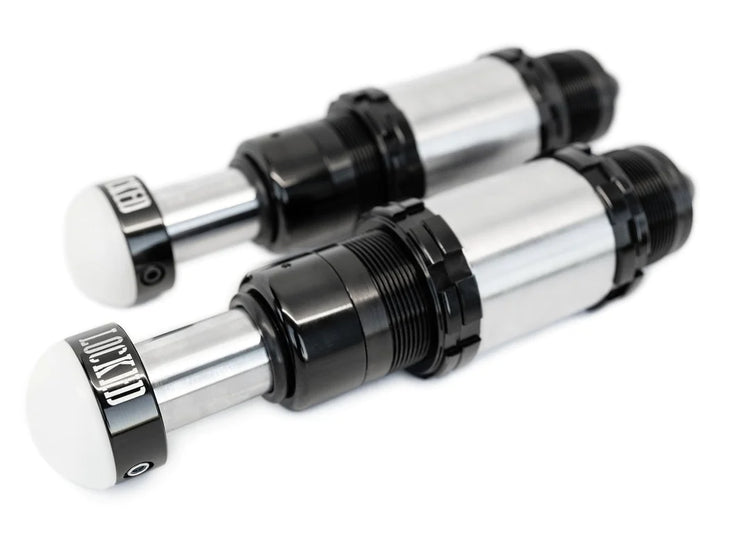What are bump stops and why should you use them?
Bump stops are important in providing a comfortable suspension setup for your rig. Their simplicity makes them easy to install and they have a huge role to play in your vehicle suspension system. Owners use bump stops for better stability, lowering swaying, when loading up heavy gear and when the road surface gets rough.
In this guide we will explore what a bump stop is, the different types of bump stops, all the advantages of using bump stops and the best bump stops available as your next vehicle upgrade.
What are bump stops?
Bump stops or “Jounce Bumpers” are components added to a vehicle suspension setup to aid in absorbing shock and provide further cushioning. Bump stops help reduce component damage as they act as a barrier to prevent rubbing between metal suspension components.
They also reduce the axles movement upwards by not allowing contact between the tires and the fenders. As without bump stops, tires and fenders can collide on rough surfaces and have the potential to cause damage. Bump stops give owners the ability to mount larger shock absorbers to their vehicles for a beefed-up look.
Bump stops provide a longer life for suspension components as they do not allow full movement of the springs and axles on the vehicle. As the bump stop provides a barrier, without one your suspension can bottom out and cause damage. Lowering kits and bump stops work together to lower the impact of bottoming out and protects the driver and the vehicle against damage.
Different Types of Bump Stops
Rubber Bump Stops
Most factory and aftermarket bump stops are made from rubber. The natural material acts as an absorbent to harsh bounces after the vehicle suspension bottoms out.
SRQ Fabrications rubber bump stops for 3rd Gen 4Runners are DuroBumps branded and mount to the rear. The 5.25in Bump stop Kit provides greater comfort than OEM bump stops thanks to their dual durometer (hardness) rubber.
Rubber bump stops for specific vehicles are easy to install as they mount to the factory mounting points.
Hydraulic Bump Stops
Essentially these are just like shock absorbers. Except where one side is attached to the chassis, the other side is left unattached. Hydraulic bump stops are available in different sizes.
Here at SRQ Fabrications, our Locked Offroad Threaded Bump Stops are 2.0" and have a stroke of 2.0”- 4.0" and cope with extremely high loads. They contain oil, are charged with nitrogen and come with adjustable shim pads - similar to a shock absorber.
Hydraulic bump stops are more hard wearing than rubber and are ideal for those tackling the rough terrain often. With the ability to weld directly onto the vehicle, they are used in racing and high-speed runs on rough terrain. Ideal for getting the best lap times or improving time trial runs because they can be adjusted for compression and rebound. With internal valve adjustment and nitrogen pressure alteration you can tune to an optimum level for your needs.
Why should you use Bump Stops?
Suitable for all terrains, bump stops are installed to give greater comfort for occupants. They are a handy way to reduce the likelihood of your suspension failing on you when tackling the rough stuff.
Safety is important no matter where you’re driving. Bump stops keep the suspension system components safe, especially for off-road vehicles. With rough terrains increasing the chance of suspension bottoming out, drivers use bump stops on unpaved roads. Taking it further, off-road enthusiasts use bump stops when crawling on rocks to reduce harsh landings of the vehicles suspension to prevent bottoming out.
Bump stops are ideal when combining quick driving and uneven roads. As the fast-paced movement means suspension needs to adjust quickly. The forces that suspension components bear means they are more likely to bottom out without a bump stop. Controlling the rebound energy and lowering the stress on a vehicle’s shocks. Bump stops also provide owners with greater control over their vehicle, with improved handling on jagged terrain when driving at a fast pace.
Owners with trucks that carry heavy loads use bump stops to reduce the pressure on their suspension system. When towing, bump stops absorb the additional pressures associated with carrying another vehicle from A to B.
Do My Bump Stops Need Replacing?
Typically, bump stops last a while. There are instances where weather conditions and debris cause them to crack and break down. It is advised to check them for damage every few months and work out if they can still absorb impacts. Here are some tell-tale signs that your existing bump stops need replacing.
Riding Uncomfortably
The aim of bump stops is to improve your ride and reduce bottoming out. If your rig is not comfortable when hitting the rough stuff then it could be a sign your bump stops need replacing.
Trailers Swinging
Bump Stops reduce the chances of rolling and improve stability. When you tow a trailer, and it starts to sway, then it may indicate a failed bump stop. Even more noticeable when driving alongside a heavy truck or during windy days.
Slumping Suspension
When carrying heavy loads bump stops are intended to absorb the weight and prevent bottoming out. If you notice during heavy loads that your vehicle is sitting quite low, then it can be a sign your bump stops need replacing.
Body Roll
Using bump stops reduces the chances of feeling body roll when cornering. If you seem to be rolling more around corners and not having level stance on the road, the chances are your bump stops need replacing.
Bump stops are necessary addition to your vehicle when tackling the rough stuff. Available in rubber or hydraulic construction they are the key safety feature that you need. Check out SRQ Fabrication’s range of bump stops for your off-roader today. We specialize in 4Runner, Tacoma, Tundra, FJ Cruiser, Bronco parts and more to enhance your next adventure!



